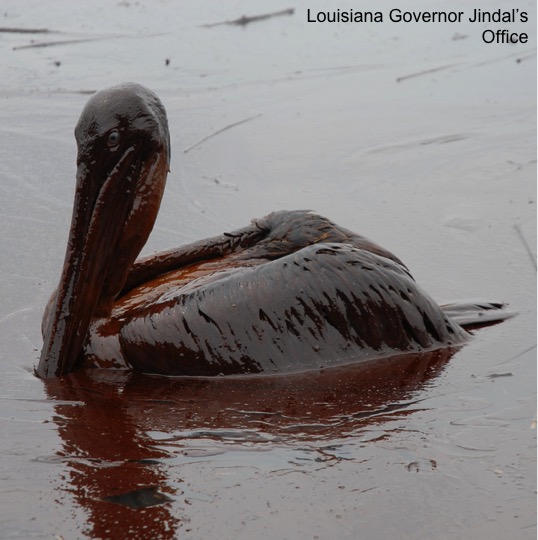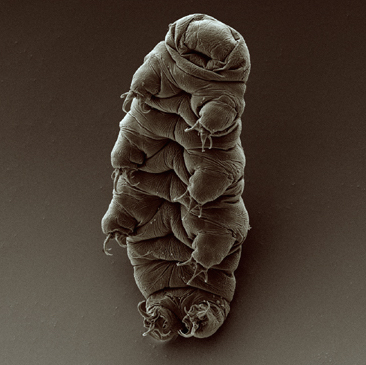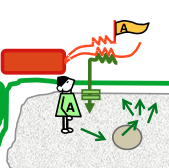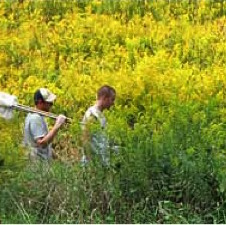Labs & Activities

Oh Deer- Project WILD
2012 CIBT Alumni Workshop
Animals
Ecology
High School
Middle School
Students simulate a deer population and its “limiting factors” of water, food, and shelter, which are represented by strips of colored paper. “Deer” who are unable to find a match for their limiting factor do not survive the round, and instead becoming limiting factors. The data is collected and graphed,… read more of the article entitled “Oh Deer- Project WILD”

Oil Spills Lab- Kristen Pizarro
2012 CIBT Alumni Workshop
Ecology
Inquiry/Scientific Method
Middle School
Plants
This activity, used as a 7th grade science laboratory final exam, comes in three sections. Students will first model an oil spill and test materials for cleaning it up. This experiment will help them understand why it is such a difficult task. Next they will examine data about the effects… read more of the article entitled “Oil Spills Lab- Kristen Pizarro”

Plant Game
Ecology
High School
Middle School
Physiology
Plants
This exercise helps students think about how plants grow in a fun and enticing manner. Teams of students “grow a plant” composed of “leaves,” “roots,” and “flowers.” The goal of the game is to produce a maximum number of flowers, which is possible only if the students have a good strategy to… read more of the article entitled “Plant Game”

Predator-Prey Population Oscillation- Bridget Henshaw
2012 CIBT Alumni Workshop
Animals
Ecology
High School
Middle School
This activity introduces students to the oscillating relationship between predator and prey population sizes. Students manipulate small “creatures” (anything from gummy worms to animal crackers to plastic animals) with differing numbers of predators/prey and calculate population changes between rounds of predation. Data is graphed in Excel at the end. Downloads… read more of the article entitled “Predator-Prey Population Oscillation- Bridget Henshaw”

Primary Productivity Lab- modified by Sean McGlynn
2012 CIBT Alumni Workshop
Animals
Ecology
High School
Inquiry/Scientific Method
Physical Sciences
Plants
Students will use LaMotte Test Kits to determine the concentration of dissolved oxygen (DO) in various water samples. The process involves adding some chemicals to the water to “fix” the free oxygen (O2). Once the O2 is fixed, they will add an acid powder, some starch, and titrate to determine… read more of the article entitled “Primary Productivity Lab- modified by Sean McGlynn”

Tardigrade Lab
Ecology
Evolution
Microbiology
Middle School
Downloads Students will explore the microscopic world found living on lichens and mosses. Using a simple collection and extraction process, students will observe extremophiles called tardigrades. This lab includes a reading activity with questions as well as an anticipation guide handout for use with a YouTube video Tardigrade Lab (Student… read more of the article entitled “Tardigrade Lab”

Vegevaders- PPI
Ecology
High School
Microbiology
Plants
Playing this game allows students to experience through game-play the continuing co-evolution between plants and their microbial pathogens that occurs during the battle to detect/defend (plants) versus evade/invade (pathogens). This battle is ongoing in nature over evolutionary time and observable in agricultural fields from one season to another, where crop… read more of the article entitled “Vegevaders- PPI”

Web of Gold Activity- Robert Raguso
2012 CIBT Alumni Workshop
Ecology
Elementary School
High School
Inquiry/Scientific Method
Insects
Middle School
Plants
“Web of Gold” uses common autumn wildflowers to explore the hidden lessons of food webs. Different insects visit flowers in search of different resources, in varying levels of abundance. Students will observe visitors to a flower (or area of flowers) and record their species and abundance. Older students can explore… read more of the article entitled “Web of Gold Activity- Robert Raguso”

Whales
Animals
Ecology
Elementary School
Evolution
Middle School
The Whale Kit full teachers’ manual provided below contains background information, handouts, games, and laboratory exercises related to all aspects of whale biology, from the massive blue whale to the smallest harbor porpoise. Students will explore anatomy, evolution, feeding strategies, migration, communication, behavior, conservation, and cultural whale tales. Kit activities target elementary and middle school ocean science… read more of the article entitled “Whales”

World of Crickets
Ecology
Elementary School
High School
Inquiry/Scientific Method
Insects
Middle School
Recently Updated!
“The World of Crickets” is a series of lab activities involving live crickets kept in the classroom that can be modified to suit students of all ages. Lab 4 is best suited for older students, as it requires experimental design and execution. Lab 1: What Do Crickets Eat? Students will… read more of the article entitled “World of Crickets”

